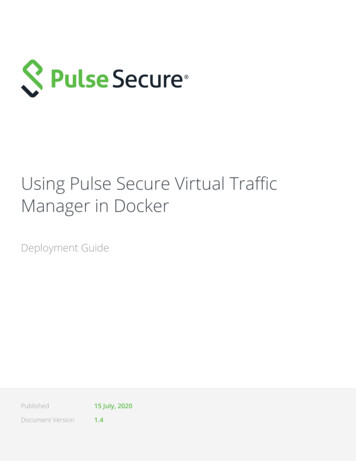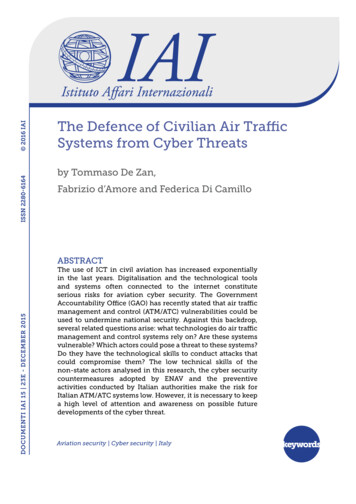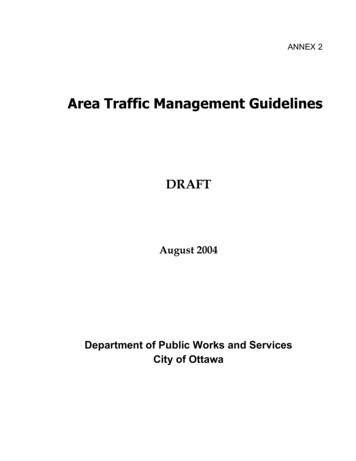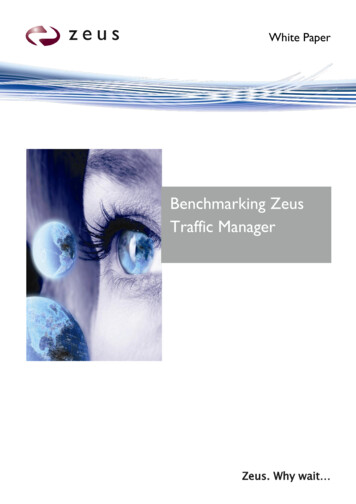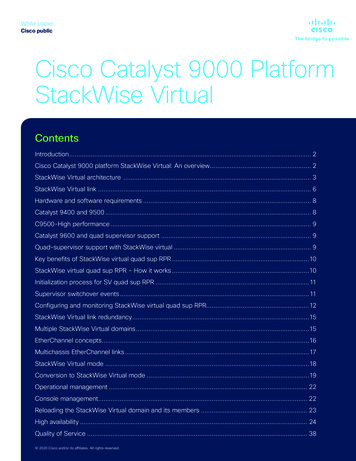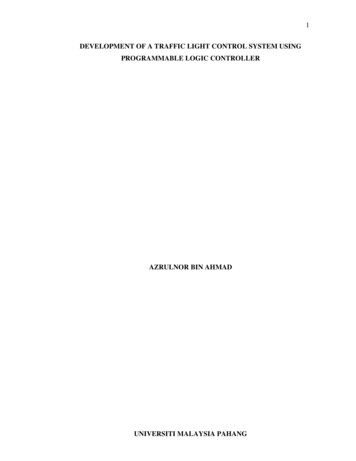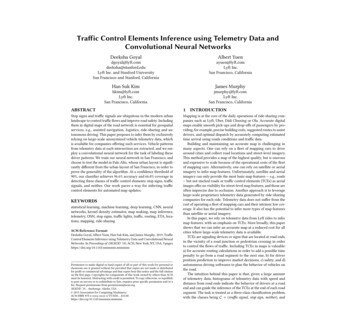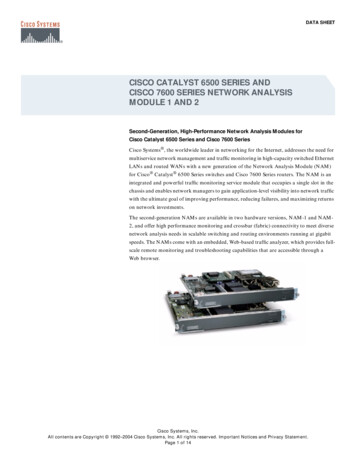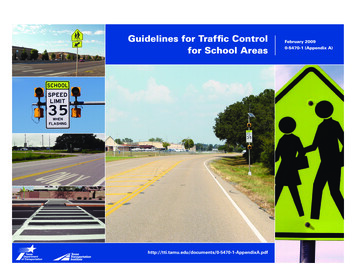
Transcription
Guidelines for Traffic Controlfor School ixA.pdfFebruary 20090-5470-1 (Appendix A)
APPENDIX AGUIDELINES FOR TRAFFIC CONTROL FOR SCHOOL AREASofTxDOT REPORT 0-5470-1: SPEEDS IN SCHOOL ZONESProject 0-5470Project Title: Comprehensive Guide to Traffic Control Near SchoolsPerformed in cooperation with theTexas Department of Transportationand theFederal Highway AdministrationSeptember 2008Published: February 2009TEXAS TRANSPORTATION INSTITUTEThe Texas A&M University SystemCollege Station, Texas 77843-3135
TABLE OF CONTENTSPageAPPENDIX A GUIDELINES FOR TRAFFIC CONTROL FOR SCHOOL AREASLIST OF FIGURES . A-ivLIST OF TABLES . A-ivINTRODUCTION . A-1SCHOOL LOCATION . A-1DEFINITIONS. A-1SCHOOL AREA. A-3SCHOOL SPEED LIMIT ZONE . A-3SCHOOL SPEED LIMIT ZONE CHARACTERISTICS . A-9School Speed Limit Value . A-9School Speed Limit Zone Beginning Location . A-9School Speed Limit Zone Length . A-10School Buffer Zone . A-10Active Times . A-13School Speed Limit Zone Marking . A-13SCHOOL PAVEMENT MARKINGS . A-13SCHOOL MARKED CROSSWALK . A-13SCHOOL ENTRANCE WARNING ASSEMBLY . A-20CONDITIONS FOR REMOVING A SCHOOL SPEED ZONE . A-20A-iii
LIST OF FIGURESPageFigure A-1. Typical School Area Signing (See Table A-1 for Suggested Dimensions for Distance d). . A-4Figure A-2. Typical School Speed Limit Zone with Marked Crosswalk at a Two-Way Stop Controlled Intersection (SeeTable A-2 for Suggested Dimensions for Distance d1, d2, and d3). . A-7Figure A-3. Typical School Speed Limit Zone with Marked Crosswalk at Midblock (See Table A-2 for Suggested Dimensionsfor Distance d1, d2, and d3). . A-8Figure A-4. Typical School Speed Limit Zone with School Buffer Zones, Example Shown for Posted Speed of 70 mph (seeTable A-4 for Suggested Dimensions for Distance d1, d2, d3, d4, and d5). . A-12Figure A-5. Typical School Signing for Marked Crosswalk at a Two-Way Stop Controlled Intersection (see Table A-5 forSuggested Dimensions for Distance d). . A-17Figure A-6. Typical School Signing for Marked Crosswalk at an All-Way Stop Controlled Intersection (see Table A-5 forSuggested Dimensions for Distance d). . A-18Figure A-7. Typical School Signing for Marked Crosswalk at a Signalized Intersection (see Table A-5 for SuggestedDimensions for Distance d). . A-19Figure A-8. School Entrance Warning Assembly Example (see Table A-6 for Suggested Dimensions for Distance d). . A-21LIST OF TABLESPageTable A-1.Table A-2.Table A-3.Table A-4.Table A-5.Table A-6.Suggested Dimensions for Distance d in Figure A-1. . A-3Suggested Dimensions for Distances in Figure A-2 and Figure A-3. . A-6Suggested School Speed Limit Based on 85th Percentile Speed. . A-9Suggested Dimensions for Distances in Figure A-4. . A-11Suggested Dimensions for Distances in Figure A-5, Figure A-6, and Figure A-7. A-16Suggested Dimensions for Distances in Figure A-8. . A-20A-iv
INTRODUCTIONTo achieve uniformity of traffic control in school areas, comparable traffic situations need to be treated in a consistent manner. TheTexas Manual on Uniform Traffic Control Devices (TMUTCD) Part 7 (available at:http://www.txdot.gov/txdot library/publications/government/project development/traffic operations.htm) provides information ontraffic control devices related to schools. The Texas Department of Transportation (TxDOT) manual on Procedures for EstablishingSpeed Zones provides information on school speed zones. A recent TxDOT project (0-5470) investigated school speed zones anddeveloped the Guidelines for Traffic Control for School Areas contained in this appendix. The purpose of these Guidelines is toaugment the TMUTCD by providing additional background and information to assist in the traffic control device applications. TheGuidelines are not intended to establish policy or procedures; rather they are to give typical guidance. Although the text may containthe words “shall,” “should,” or “may,” it is not intended that these words or their usage have the same implications as in theTMUTCD. An engineering and traffic investigation should be conducted to determine the need for a school speed limit as well as allappropriate traffic control devices.SCHOOL LOCATIONA previous TxDOT research project developed recommended guidelines regarding traffic operations and safety at schools (availableat: http://tti.tamu.edu/documents/4286-2.pdf). An initial principle developed and emphasized in several discussions is the desire tohave schools located with appropriate accessibility from the adjacent roadway network based on the type of school. One of theprominent site selection criteria was to avoid locations with direct access to high-speed roadways (e.g., trunk highways and frontageroads). Locations should be chosen on roadways with the lowest speed limit and/or lowest average daily traffic. Also suggested wasto locate a school so that students approaching on foot would not have to cross main traffic routes and to consider locating schoolsadjacent to other community facilities where there is potential for shared-use parking (e.g., parks, churches, etc.).Maintaining contact with school officials can help TxDOT become aware of proposed school site designs at an early stage. Whenproposed building plans are known, suggestions on access points can be made that could minimize future problems. Also theinstallation of appropriate safety and traffic control devices can be scheduled to be in place when needed. An engineering and trafficinvestigation should be conducted to determine the need for traffic control devices.DEFINITIONSFollowing are definitions for use with these Guidelines.A-1
School location where children in grades from kindergarten through the 12th grade receive academic instruction.School Area the portion of the roadway adjacent to school building(s) or grounds or where school-related activity is occurring.School Zone a defined portion of a roadway associated with a school.School Speed Limit Zone a defined portion of the roadway where a school speed limit is present.School Speed Limit a speed limit posted in a school zone that is lower than the regulatory speed limit in that zone and is applicableduring specific times of day on school days, when children are present, or when beacons are flashing.School Buffer Zone a defined portion of the highway in advance of and/or following a school speed limit zone where a school bufferspeed limit is present.School Buffer Speed Limit a speed limit posted in a school zone that is lower than the regulatory speed limit in that zone but higherthan the school speed limit, used to provide a transition between higher posted speed and school zone speed; it is applicable during thesame time periods as the associated school speed limit.School Entrance Warning Assembly combination of signs warning drivers of the presence of a school entrance. The combinationmay be accompanied by an advisory speed plaque.School Route Plan (also known as School Route Map) a plan developed in a systematic manner by the school, law enforcement, andtraffic officials responsible for school pedestrian safety. It consists of a map showing streets, the school, existing traffic controls,established school walk routes, and established school crossings. See the TMUTCD or Safe Routes to School website(http://www.saferoutesinfo.org/) for additional discussion. School speed limit zones shall only be located along child access routes asindicated on the school route plan.Traffic Control Devices all signs, signals, markings, and other devices used to regulate, warn, or guide traffic, placed on, over, oradjacent to a street, highway, pedestrian facility, bikeway, public facility, or private property open to public travel by authority of apublic agency or official having jurisdiction.A-2
SCHOOL AREASome jurisdictions find it beneficial to advise road users that they are approaching a school that is adjacent to a highway, whereadditional care is needed, even though no school crossing is involved and the speed limit remains unchanged. The portion of theroadway adjacent to school building or grounds or where school-related activity is occurring adjacent to the highway can be defined asthe “school area.” The S1-1 School sign can be used to warn road users that they are approaching a school area. Figure A-1 shows anexample of signing for a school area. Table A-1 lists suggested dimensions for the spacing distance shown in Figure A-1.Table A-1. Suggested Dimensions for Distance d in Figure A-1.Posted or 85th percentile speed (mph)25303540455055606570Distance (d) between School (S1-1) sign 100 to 100 to 100 to 125 to 175 to 250 to 325 to 400 to 475 to 550 toand school driveway (ft)325450550650750850950110012001250SCHOOL SPEED LIMIT ZONEA school speed limit zone can be considered for the following conditions: School-age pedestrians are crossing the major roadway going to and from school. School is located adjacent to highways or is visible from highways.School speed limit zones are typically not used at signalized or stop-controlled intersections because their traffic control creates gapsthat can be used by school-age pedestrians to cross a roadway. A school speed limit zone may be installed, or may be allowed toremain, at a roundabout, signalized, or stop-controlled intersection as a mitigation measure for concerns related to sight distance,grade, or other critical issues, as determined by an engineering study.The school speed limit zone is to be shown on the School Route Plan.A speed zone strip map should be prepared if a reduced school speed limit is planned. A regular speed zone must not change withinthe limits of a school speed zone since posting of a Speed Limit (R2-1) sign would prematurely terminate the school speed zone.Speed limits remain fixed until a revised limit is encountered.A-3
END SCHOOLZONE 1-1School DrivewayS4-3P(Optional)SchoolSignS5-2END SCHOOLZONE SignNotes:a. Proposed for the 2008 revisions to the MUTCD.Sign not currently used as a standard in Texas.Figure A-1. Typical School Area Signing (See Table A-1 for Suggested Dimensions for Distance d).A-4
The signing and markings for a school speed limit zone can include the following: the Reduced School Speed Limit Ahead (S4-5, S4-5a) sign (if included), the School Advance Crossing assembly (if included), SCHOOL marking on pavement (if included), the School Speed Limit (S5-1) sign, the School Crossing assembly (if included) and marked crosswalk (if included), the solid white school speed limit zone marking, and the appropriate Speed Limit (R2-1) sign. (Note that the 2008 proposed revisions to the MUTCD changes the requirement forthe sign at the end of a school speed limit zone to include the END SCHOOL ZONE (S5-2) sign in combination with a SpeedLimit (R2-1) sign on the same pole. TxDOT is examining the recommendation and will make a decision following thepublication of the next edition of the MUTCD.)Typical signing and pavement markings for a school speed limit zone are shown in Figure A-2 and Figure A-3. Table A-2 includesthe suggested dimensions for distance d1, d2, and d3 (shown in Figure A-2 and Figure A-3).Districts should initiate the installation of school speed limit signs and flashers immediately after submitting the request to the TrafficOperations Division (TRF) for Commission action or city ordinance approval. These signs should be in operation as soon as practicalafter the minute order is approved by the Transportation Commission or the city ordinance is approved by the city. If, for somereason, there is a delay in the installation of a school flasher, other static signs for school zones can be installed as temporary measuresafter the minute order or city ordinance is enacted.A-5
Table A-2. Suggested Dimensions for Distances in Figure A-2 and Figure A-3.2530354045505560Posted or 85 percentile speed (mph)Distance (d3) between Reduced School Speed Limit Ahead(S4-5) sign (optional) and School Advance Crossing100 120 160 240 320 400 500 600assembly (ft)Distance (d2) between School Advance Crossing assembly100 120 160 240 320 400 500 600and School Speed Limit (S5-1) sign (ft)Distance (d1) between School Speed Limit (S5-1) sign andschool driveway or marked crosswalk (and School Crossing 200 200 200 300 300 4001 4001 4001assembly, when appropriate) (ft)Minimum solid white lane line in advance of marked200 200 200 300 300 4001 4001 4001crosswalk or school driveway (ft)NOTES:th165707008007008004001400140014001On higher-speed roadways a system of treatments is needed for pedestrians—a marked crosswalk should not be used without additionalpedestrian treatments. The installation of a marked crosswalk and pedestrian signs does not necessarily result in more vehicles stopping forpedestrians. Therefore, treating a location to improve pedestrian access or safety should include several components. For example, inaddition to traffic control devices, geometric improvements may be used to shorten the crossing distance. Traffic calming may be used toslow vehicle speeds near the pedestrian crossing. Additional traffic control devices may be needed.A-6
Solid white school speedlimit zone d SchoolSpeed Limit AheadSign hoolSpeedLimit Sign(d3)School pavement markings (optional)can extend across one or two lanesSolid white lane lineSolid white lane line(d2)S4-5W16-2PSolid white school speedlimit zone markingSchool pavementmarkings (optional)can extend acrossone or two lanesW16-9PW16-7(d1)(d3)Reduced SchoolSpeed Limit AheadSign (Optional)School AdvanceCrossingAssemblySchoolSpeedLimit SignSchoolCrossingAssemblyEND SCHOOLZONE Sign &Speed Limit SignaNotes:a. Proposed sign combination for the 2008revisions to the MUTCD, not currently used asa standard in Texas. Current practice is to useonly Speed Limit sign or END SCHOOL ZONEsign at end of school speed limit zone.A NO CELL PHONE USE BY CITYORDINANCE sign can be used when acity has an appropriate city ordinanceregarding cell phone restrictions. Thelocation of the sign should be in advanceof the school zone and within the city limits(unless other specific guidance is provided inthe city ordinance) and approved by theTxDOT district when on a TxDOT road.Figure A-2. Typical School Speed Limit Zone with Marked Crosswalk at a Two-Way Stop-Controlled Intersection (See TableA-2 for Suggested Dimensions for Distance d1, d2, and d3).A-7
END SCHOOLZONE Sign &Speed Limit SignaSchool AdvanceCrossingAssemblySchoolSpeedLimit SignSchoolYield Here ToCrossing Pedestrians &Yield LineAssemblyc(Optional)bS5-2Reduced SchoolSpeed Limit AheadSign 2P(d1)(d2)(d3)20'50'Solid whitelane lineYield Line(Optional)bSolid white school speedlimit zone markingSolid whitelane lineSchool pavement markings (optional)can extend across one or two lanesSolid white school speedlimit zone markingSchool pavement markings (optional)can extend across one or two LS1-1W16-7R2-1W16-2PReduced SchoolSpeed Limit AheadSign Limit SignYield Here ToPedestrians &Yield Line(Optional)bSchoolCrossingAssemblycEND SCHOOLZONE Sign &Speed Limit SignaNotes:a. Proposed sign combination for the 2008 revisionsto the MUTCD, not currently used as a standardin Texas. Current practice is to use only SpeedLimit sign or only END SCHOOL ZONE sign atend of school speed limit zone.b. If used shall be used together.c. When the Yield Here To Pedestrians sign is used,verify in the field that School Crossing assemblyis visible.A NO CELL PHONE USE BY CITYORDINANCE sign can be used when a cityhas an appropriate city ordinance regardingcell phone restrictions. The location of thesign should be in advance of the schoolzone and within the city limits (unless otherspecific guidance is provided in the city ordinance)and approved by the TxDOT district when on aTxDOT road.Figure A-3. Typical School Speed Limit Zone with Marked Crosswalk at Midblock (See Table A-2 for Suggested Dimensionsfor Distance d1, d2, and d3).A-8
SCHOOL SPEED LIMIT ZONE CHARACTERISTICSSchool Speed Limit ValueThe suggested value for the school speed limit is listed in Table A-3. Factual studies, reason, and sound engineering judgment, ratherthan emotion, should govern the final decision on the maximum deviation from the 85th percentile speed, which will provide areasonable and prudent speed limit.Table A-3. Suggested School Speed Limit Based on 85th Percentile Speed.85 Percentile Speed Suggested School Speed LimitBelow 55 mphNot more than 15 mph below 85th percentile speed or postedspeed. Not to exceed a 35 mph school speed limit.55 mph20 mph below the 85th percentile speed or posted speedGreater than 55 mphUse buffer zone to transition to a 35 mph school speed limitthSchool Speed Limit Zone Beginning LocationThe 2006 TMUTCD states that the School Speed Limit Zone should begin either at a point 200 ft from the crosswalk, or from the firstdriveway on school property, whichever is encountered first as traffic approaches the school. Researchers suggest having thebeginning of the School Speed Limit Zone based upon the school speed limit as follows:School Speed Limit(mph)20253035Distance to Crosswalkor First Driveway (ft)200200300400The location of the beginning and end of a school speed limit zone should be based on engineering judgment rather than the exactlocation of the school property line or fence. A practice in Texas is to end the school speed limit zone at the same location as theopposing school speed limit zone begins and to use a transverse solid white line across all travel lanes to mark the beginning andending of a school speed limit zone.A-9
School Speed Limit Zone LengthThe school speed limit zone should be centered at the location(s) where school-age pedestrians are crossing the roadway or whereschool-related traffic is leaving and entering the roadway. The beginning and ending points should be selected with appropriateconsideration for the location of other traffic control devices and/or features that could impact the effective implementation of theschool speed limit zone.School speed limit zones in urban areas where speeds are 30 mph or less may have school zones as short as 400 ft.School speed limit zones in rural areas where regulatory posted speeds are typically 55 mph or more will have longer school zones.The suggested length for zones in rural areas is 1000 ft.Research has shown that speeds are approximately 1 mph higher for every 500 ft driven within a school zone; therefore, longer schoolzones are associated with greater speed variability within the zone.When the speed reduction between the regulatory speed limit and the selected school speed limit is greater than 20 mph, a buffer zoneis to be used (see following section on School Buffer Zones). Buffer zones are typically 500 ft in length.School Buffer ZoneAny roadway with an 85th percentile speed greater than 55 mph is to have a buffer zone to transition to a 35-mph school speed limit.Buffer zones permit motorists to travel at the higher posted speeds through both zones when slower speeds are not necessary. Anexample of a buffer zone is where the regulatory posted speed limit is 70 mph and the school speed limit is 35 mph. In this case abuffer zone of 55 mph can be used on the approach and departure sides of the 35-mph school speed limit zone (see Figure A-4). TableA-4 includes the suggested dimensions for the distances shown in Figure A-4.The basic design for a Buffer School Zone (S5-1) sign is the same as for a regular School Speed Limit (S5-1) sign. The SCHOOLSPEED LIMIT XX WHEN FLASHING sign should be used where TxDOT is responsible for signing school speed limit zones andschool buffer zones. The buffer zone beacons can be activated up to 5 minutes earlier than the school speed limit zone to eliminatedrivers who pass through the buffer zone while it is inactive seeing active beacons only in the lower speed zone.A-10
Table A-4. Suggested Dimensions for Distances in Figure A-4.Posted or 85 Percentile Speed (mph)School Speed Limit (mph)Suggested Buffer Speed Limit (mph)Distance (d1) Between School (S1-1) sign to School Buffer Speed Limit (S5-1) sign (ft)Distance (d2) Between School Buffer Speed Limit (S5-1) sign to School Speed Limit (S5-1) sign (ft)Distance (d3) Between School Speed Limit (S5-1) sign to school driveway (ft)Distance (d4) Between school driveway to School Buffer Speed Limit (S5-1) sign (ft)Distance (d5) Between School Buffer Speed Limit (S5-1) sign to Speed Limit (R2-1) sign (ft)thA-11703555800656035355050700 600500400Same as d3Same as d2
SchoolSpeedLimit SignSchoolSpeedLimit SignEND SCHOOLZONE Sign &Speed Limit SignaSchoolSignBuffer SchoolSpeedLimit (d1)Solid white school speedlimit zone markingSolid white school speedlimit zone SignBuffer SchoolSpeedLimit SignSchoolSpeedLimit SignSchool DrivewayR1-1S5-2aS5-1R2-1SchoolSpeedLimit SignEND SCHOOLZONE Sign &Speed Limit SignaNotes:a. Proposed sign combination for the 2008revisions to the MUTCD, not currentlyused as a standard in Texas. Currentpractice is to use only Speed Limit signor END SCHOOL ZONE sign at end ofschool speed limit zone.b. Speed limit values are provided asexamples.A NO CELL PHONE USE BY CITYORDINANCE sign can be usedwhen a city has an appropriate cityordinance regarding cell phonerestrictions. The location of the signshould be in advance of the school zoneand within the city limits (unless otherspecific guidance is provided in the cityordinance) and approved by the TxDOTdistrict when on a TxDOT road.Figure A-4. Typical School Speed Limit Zone with School Buffer Zones, Example Shown for Posted Speed of 70 mph (seeTable A-4 for Suggested Dimensions for Distance d1, d2, d3, d4, and d5).A-12
Active TimesGenerally, the zones indicated on the signs should be in effect only during the following specified intervals: from approximately 30 minutes before and 5 minutes after classes begin, from the beginning to the end of the lunch period for open campuses, and from approximately 5 minutes before and 30 minutes after classes end.The intervals of operation of the flashing beacons on the school speed limit assemblies may be extended or revised for school eventsas mutually agreed upon by the school district and the entity responsible for the operation of the flashing beacons. In this case, theflashing beacons should only be operated when there is an increase in vehicular activity and/or pedestrian traffic in and around theroadway associated with the school event.Research has shown that operating speeds in an active school speed zone are at their lowest close to the start time or end time of theschool day. Approximately 20 minutes before or after the start of school, speeds are 1 mph higher and increase as time increases awayfrom the start or end bells.School Speed Limit Zone MarkingWhere greater emphasis is needed to indicate the beginning and ending points of an established school speed limit zone, a 12- to 18inch solid white transverse line may be used. The transverse line shall be located immediately adjacent to the School Speed Limitassembly or School Speed Limit sign.SCHOOL PAVEMENT MARKINGSThe SCHOOL pavement marking is used to supplement signs and provide additional emphasis. The SCHOOL word marking widthmay either be the width of one lane or can extend to the width of two approach lanes. When extended to two approach lanes, themarkings are 10 ft (3 m) or more in height.SCHOOL MARKED CROSSWALKCrosswalk markings provide guidance for pedestrians who are crossing roadways by defining and delineating paths on approaches toand within signalized intersections, and on approaches to other intersections where traffic stops. In conjunction with signs and othermeasures, crosswalk markings help to alert road users of a designated pedestrian crossing point across roadways at locations that areA-13
not controlled by traffic control signals or STOP signs. At nonintersection locations, crosswalk markings legally establish thecrosswalk.Because nonintersection marked crossings are generally unexpected by the road user, additional treatments should be installed for allmarked school crosswalks at nonintersection locations. These treatments can include warning signs and high-visibility markings as aminimum. Other treatments can include school crossing guards or pedestrian-activated treatments. Adequate visibility of students byapproaching motorists and of approaching motorists by students should be present. Parking prohibitions may be needed to provide thedesired sight distance.Warrants have not been established for pedestrian crosswalks in the TMUTCD or the MUTCD; however, guidance material isavailable, including in the following reports: TCRP Report 112/NCHRP Report 562, Improving Pedestrian Safety at Unsignalized Crossings, 2006. Available p rpt 562.pdf FHWA-RD-04-100, Safety Effects of Marked Versus Unmarked Crosswalks at Uncontrolled Locations Final Report andRecommended Guidelines. Full report available at: http://www.tfhrc.gov/safety/pubs/04100/04100.pdf. Summary reportavailable at: http://drusilla.hsrc.unc.edu/cms/downloads/Effects Un MarkedCrosswalks Summary.pdfThe 2008 proposed update to the MUTCD includes the following guidance based on information presented in the above FHWAreport:“Crosswalk lines should not be used indiscriminately. An engineering study should be performed before a markedcrosswalk is installed at a location away from a traffic control signal or an approach controlled by a STOP sign. Theengineering study should consider: The number of lanes, The presence of a medi
the solid white school speed limit zone marking, and the appropriate Speed Limit (R2-1) sign. (Note that the 2008 proposed revisions to the MUTCD changes the requirement for the sign at the end of a school speed limit zone to include the END SCHOOL ZONE (S5-2) sign in com




